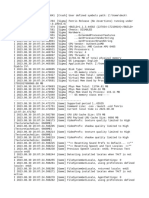Linker
➢ In execution of the program, major role is played by two programs known
as Linker and Loader.
➢ A linker is special program that combines the object files, generated by
compiler/assembler, and other pieces of codes to originate an executable file
have. exe extension. Linker are also called link editors.
➢ In the object file, linker searches and append all libraries needed for execution
of file.
➢ It regulates memory space that code from each module will hold. It also
merges two or more separate object programs and establishes link among them.
45
�➢ Linking is performed at both compile time, when the source code is
translated into machine code and load time, when the program is loaded
into memory by the loader
➢ Generally, linkers are of two types :
1. Static Linker
2. Dynamic Linker
1. Static Linking –
➢ It is performed during the compilation of source program. Linking is
performed before execution in static linking.
➢ It takes collection of relocatable object file and command-line argument and
generate fully linked object file that can be loaded and run.
46
�➢ Static linker perform two major task:
1) Symbol resolution – It associates each symbol reference with exactly one
symbol definition .Every symbol have predefined task.
2) Relocation – It relocate code and data section and modify symbol
references to the relocated memory location.
➢ The linker copy all library routines used in the program into executable
image. As a result, it require more memory space.
➢ As it does not require the presence of library on the system when it is run .
so, it is faster and more portable.
➢ No failure chance and less error chance.
47
�2. Dynamic linking – Dynamic linking is performed during the run time. This
linking is accomplished by placing the name of a shareable library in the
executable image.
➢ There is more chances of error and failure.
➢ It require less memory space as multiple program can share a single copy of
the library.
➢ Here we can perform code sharing. it means we are using a same object a
number of times in the program.
➢ Instead of linking same object again and again into the library, each module
share information of a object with other module having same object.
➢ The shared library needed in the linking is stored in virtual memory to save
RAM.
48
�49
� Loader
➢ A loader is a piece of software that chooses exactly where to put object
code in RAM, ready for it to be run. It also adjusts the memory
references in programs.
➢ The loader is special program that takes input of object code from linker,
loads it to main memory, and prepares this code for execution by
computer. Loader allocates memory space to program.
50
�Computer Program Compilation Process
51
� Types of Loaders
1) Absolute Loader
2) Boot Strap Loader
3) Relocating Loader
4) Direct Linking Loader
5) Assemble – and – go or Compile – and – go loader
6) Dynamic Loader
52
�Assemble – and – go or Compile – and
– go loader
➢ In this type of loader, the instruction is read line by line, its machine code is
obtained and it is directly put in the main memory at some known address.
➢ Assembler runs in one part of memory and the assembled machine
instructions and data is directly put into their assigned memory locations.
➢ After completion, the assembly process assigns the starting address of the
program to the location counter.
53
�Advantages
This scheme is simple to implement because assembler is placed at one part of
the memory and loader simply loads assembled machine instructions into the
memory.
Disadvantages:
• In this scheme, some portion of memory is occupied by assembler which is
simply a wastage of a memory. As this scheme is a combination of assembler
and loader activities this combination program occupies a large block of
memory.
• There is no production of .obj file, the source code is directly converted to
executable form. Hence even though there is no modification in the source
program it needs to be assembled and executed each time which then become a
time-consuming activity.
• It cannot handle multiple source program or multiple programs written in
different languages. This is because assembler can translate one source language
to another target language.
• The execution time will be more.
54
� General Loader Scheme
➢ This scheme avoids the disadvantages of preceding “compile-and-go” scheme.
➢ As the size of the loader is assumed to be smaller than the assembler, more
memory is available to the user
55
� Absolute Loader
➢ The absolute loader is a kind of loader in which relocated object files are
created, loader accepts these files and places them at a specified location in the
memory.
➢ This type of loader is called absolute loader because
no relocating information is needed, rather it is obtained from the programmer
or assembler.
56
�Program for Absolute Loader
57
� Simple Bootstrap Loader
➢ When a computer is first turned on or restarted, a special type of absolute
loader, called bootstrap loader is executed.
➢ This bootstrap loads the first program to be run by the computer -- usually
an operating system.
➢ The bootstrap itself begins at address 0. It loads the OS starting address
0x80.
58
� Linking Loaders
➢ Linking Loaders – Perform all linking and relocation at load time.
➢ The Other Alternatives are Linkage editors, which perform linking
prior to load time and, Dynamic linking, in which linking function is
performed at execution time
59
� Relocating Loader
➢ In general, the user does not know a priori where the program will reside in
memory. A relocating loader is capable of loading a program to begin
anywhere in memory:
➢ The addresses produced by the compiler run from 0 to L–1. After the
program has been loaded, the addresses must run from N to N +L–1.
➢ Therefore, the relocating loader adjusts, or relocates, each address in the
program
60
� Direct Linking Loader
➢ Direct Linking Loader is a general re-locatable loader.
➢ Allowing the programmer multiple procedure segments and multiple data
segments and giving programmer complete freedom in referencing data or
instruction contained in other segments.
➢ The assembler must give the loader the following information with each
procedure or data segment.
1) Length and type of segment
1. A list of all symbols in the segment that may be referenced by other
segments.
2. List of all symbols not defined in the segment but referenced in the
segment.
3. Information where the address constant are loaded in the segment.
61
�2) Format of Databases:
1) External Symbol Dictionary (ESD)
2) Text Cards (TXT)
3) Relocation and Linkage Directory (RLD)
4) END CARD
62
� Dynamic Loading
➢ All the programs are loaded in the main memory for execution.
➢ Sometimes complete program is loaded into the memory, but some times a
certain part or routine of the program is loaded into the main memory only
when it is called by the program, this mechanism is called Dynamic
Loading, this enhance the performance.
63
� Functions of Loader
The loader performs the following functions:
1) Allocation
2) Linking
3) Relocation
4) Loading
Allocation:
➢ Allocates the space in the memory where the object program would be
loaded for Execution.
➢ It allocates the space for program in the memory, by calculating the size of
the program. This activity is called allocation.
➢ In absolute loader allocation is done by the programmer and hence it is the
duty of the programmer to ensure that the programs do not get overlap.
➢ In reloadable loader allocation is done by the loader hence the assembler
must supply the loader the size of the program.
64
�Linking:
➢ It links two or more object codes and provides the information
needed to allow references between them.
➢ It resolves the symbolic references (code/data) between the
object modules by assigning all the user subroutine and library
subroutine addresses. This activity is called linking.
➢ In absolute loader linking is done by the programmer as the
programmer is aware about the runtime address of the symbols.
➢ In relocatable loader, linking is done by the loader and hence
the assembler must supply to the loader, the locations at which
the loading is to be done.
65
�Relocation:
➢ It modifies the object program by changing the certain
instructions so that it can be loaded at different address from
location originally specified.
➢ There are some address dependent locations in the program,
such address constants must be adjusted according to allocated
space, such activity done by loader is called relocation.
➢ In absolute loader relocation is done by the assembler as the
assembler is aware of the starting address of the program.
➢ In relocatable loader, relocation is done by the loader and
hence assembler must supply to the loader the location at
which relocation is to be done.
66






















































































